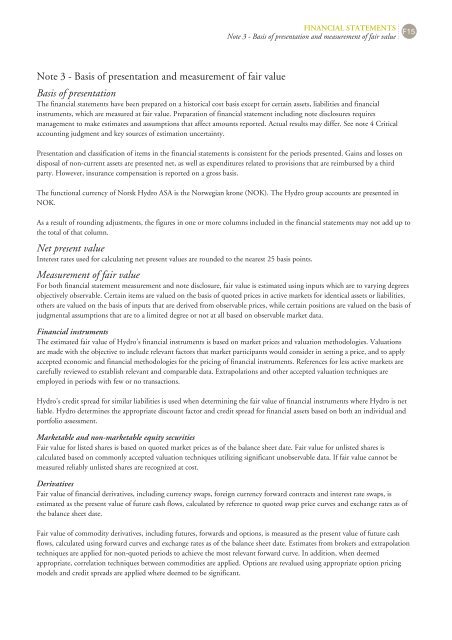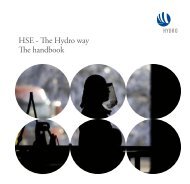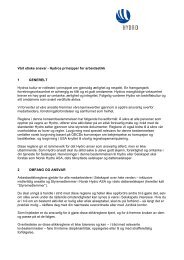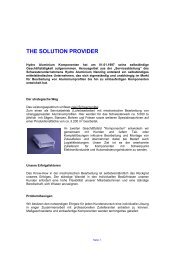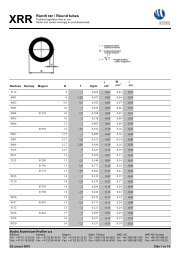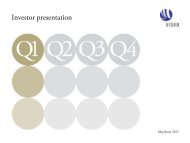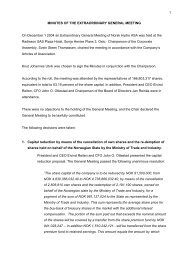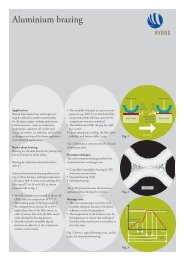Hydro Annual Report 2011b
Hydro Annual Report 2011b
Hydro Annual Report 2011b
Create successful ePaper yourself
Turn your PDF publications into a flip-book with our unique Google optimized e-Paper software.
Note 3 - Basis of presentation and measurement of fair value<br />
Basis of presentation<br />
The financial statements have been prepared on a historical cost basis except for certain assets, liabilities and financial<br />
instruments, which are measured at fair value. Preparation of financial statement including note disclosures requires<br />
management to make estimates and assumptions that affect amounts reported. Actual results may differ. See note 4 Critical<br />
accounting judgment and key sources of estimation uncertainty.<br />
Presentation and classification of items in the financial statements is consistent for the periods presented. Gains and losses on<br />
disposal of non-current assets are presented net, as well as expenditures related to provisions that are reimbursed by a third<br />
party. However, insurance compensation is reported on a gross basis.<br />
The functional currency of Norsk <strong>Hydro</strong> ASA is the Norwegian krone (NOK). The <strong>Hydro</strong> group accounts are presented in<br />
NOK.<br />
As a result of rounding adjustments, the figures in one or more columns included in the financial statements may not add up to<br />
the total of that column.<br />
Net present value<br />
Interest rates used for calculating net present values are rounded to the nearest 25 basis points.<br />
FINANCIAL STATEMENTS<br />
Note 3 - Basis of presentation and measurement of fair value F15<br />
Measurement of fair value<br />
For both financial statement measurement and note disclosure, fair value is estimated using inputs which are to varying degrees<br />
objectively observable. Certain items are valued on the basis of quoted prices in active markets for identical assets or liabilities,<br />
others are valued on the basis of inputs that are derived from observable prices, while certain positions are valued on the basis of<br />
judgmental assumptions that are to a limited degree or not at all based on observable market data.<br />
Financial instruments<br />
The estimated fair value of <strong>Hydro</strong>'s financial instruments is based on market prices and valuation methodologies. Valuations<br />
are made with the objective to include relevant factors that market participants would consider in setting a price, and to apply<br />
accepted economic and financial methodologies for the pricing of financial instruments. References for less active markets are<br />
carefully reviewed to establish relevant and comparable data. Extrapolations and other accepted valuation techniques are<br />
employed in periods with few or no transactions.<br />
<strong>Hydro</strong>'s credit spread for similar liabilities is used when determining the fair value of financial instruments where <strong>Hydro</strong> is net<br />
liable. <strong>Hydro</strong> determines the appropriate discount factor and credit spread for financial assets based on both an individual and<br />
portfolio assessment.<br />
Marketable and non-marketable equity securities<br />
Fair value for listed shares is based on quoted market prices as of the balance sheet date. Fair value for unlisted shares is<br />
calculated based on commonly accepted valuation techniques utilizing significant unobservable data. If fair value cannot be<br />
measured reliably unlisted shares are recognized at cost.<br />
Derivatives<br />
Fair value of financial derivatives, including currency swaps, foreign currency forward contracts and interest rate swaps, is<br />
estimated as the present value of future cash flows, calculated by reference to quoted swap price curves and exchange rates as of<br />
the balance sheet date.<br />
Fair value of commodity derivatives, including futures, forwards and options, is measured as the present value of future cash<br />
flows, calculated using forward curves and exchange rates as of the balance sheet date. Estimates from brokers and extrapolation<br />
techniques are applied for non-quoted periods to achieve the most relevant forward curve. In addition, when deemed<br />
appropriate, correlation techniques between commodities are applied. Options are revalued using appropriate option pricing<br />
models and credit spreads are applied where deemed to be significant.


